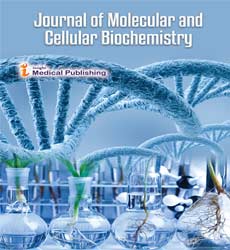The Advancement in Enzyme: Nano Enzyme
Sivam Kumar Yadav*
Department of Biochemistry, University of Delhi, Delhi, India
- *Corresponding Author:
- Sivam Kumar Yadav
Department of Biochemistry,
University of Delhi,
Delhi,
India
E-mail: yadavscology@gmail.com
Received Date: November 5, 2021; Accepted Date: November 19, 2021; Published Date: November 26, 2021
Citation: Yadav SK (2021) The Advancement in Enzyme: Nano Enzyme. J Mol Cell Biochem Vol. 5 No.5:e007
Editorial Note
Enzymes are significant biological molecules that carried out the major portion of chemical processes in all living creatures. These reactions are crucial for the proper life and are involved in a wide range of activities that give cells their chemical and physical properties. Furthermore, many enzymes are involved in chemical reactions with commercial or medicinal significance for which there are no good created molecules that can catalyse with the same precision and efficiency as enzymes. Because of its industrially relevant catalytic properties, the artificial enzyme was manufactured in a fully functional form by bact eria (E.coil) and that provide great utility to the biotech industry.
Nanozymes is a novel artificial enzyme with intrinsic enzymelike properties. Nanozymes are nanomaterial that possesses inherent enzyme-like properties. They can specifically catalyse substrates of natural enzymes with equivalent catalytic mechanism and kinetics under physiological conditions. Nanozymes have distinct advantages over natural enzymes, including high catalytic activity, relatively inexpensive, high stability, ease of mass production, and unable activity. Furthermore, Nanozymes, as a new variant of synthetic enzyme, not only have enzyme-like enzymatic activity, but also exemplify the unique chemical and physical properties of nanomaterial, such as photo thermal properties and super paramagnetic properties.
Nanozymes, a type of nanomaterial with enzyme-like activity, illustrate great potential across many areas, including biochemical detection, environmental management, and disease treatment. With the advancement of in-depth research and a broad range of technical specifications, the key research topic in this field has been the advancement of Nanozymes with catalytic performance comparable to or even exceeding that of natural enzymes. The majority of Nanozymes reported previously were obtained through random synthesis and screening, and their catalytic efficiency is so much comparable to that of natural enzymes.
Natural enzymes that have evolved over hundreds of millions of years have accumulated a wealth of high-efficiency catalytic know-how that is buried in their structural properties. Enzyme replica have demonstrated enormous activity in the catalysis of a wide range of chemical and biological reactions, the creation of chemical and biological sensors and anti-bio fouling systems, and the manufacturing of pharmaceuticals and clean fuels. Nanozymes have several advantages. They are less expensive and more easily recycled. Nanozymes may also be easily made and kept for long periods of time, lowering their cost even further. Inorganic enzymes typically require high temperatures, high pressure, and extreme pH conditions. Nanozymes, on the other side, may act in more physiological environments and respond to a variety of external stimuli. Nanozymes also have characteristics that distinguish them from other artificial enzymes, such as integrated multi-functions that are not connected to catalysis. Nano scale materials have vast surface areas, making future changes and bio conjugation easier. Nanozymes can be used in a variety of ways, including diagnostic medicine, targeted therapy, and bio sensing. The ability to diagnose disease at an early stage is critical for bettering clinical outcomes. Despite the significant possibilities of nanozymes in science and technology, present study and application are still constrained, emphasizing future obstacles and research prospects.
Open Access Journals
- Aquaculture & Veterinary Science
- Chemistry & Chemical Sciences
- Clinical Sciences
- Engineering
- General Science
- Genetics & Molecular Biology
- Health Care & Nursing
- Immunology & Microbiology
- Materials Science
- Mathematics & Physics
- Medical Sciences
- Neurology & Psychiatry
- Oncology & Cancer Science
- Pharmaceutical Sciences
